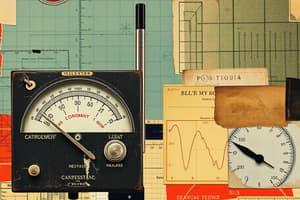Podcast
Questions and Answers
What does IPC stand for?
What does IPC stand for?
The Institute for Interconnecting and Packaging Electronic Circuits
What is the value range for Class 1 Electronics?
What is the value range for Class 1 Electronics?
$1-$100
What defines Class 2 Electronics?
What defines Class 2 Electronics?
Dedicated Service Electronic Products valued at ~$100-$20,000
What defines Class 3 Electronics?
What defines Class 3 Electronics?
What does NAPD stand for?
What does NAPD stand for?
What does A1P2D3 signify?
What does A1P2D3 signify?
What does N1D2D3 signify?
What does N1D2D3 signify?
What does D1D2D3 signify?
What does D1D2D3 signify?
In a conflict between J-STD Text and applicable documents, which takes precedent?
In a conflict between J-STD Text and applicable documents, which takes precedent?
If there is a conflict between J-STD Text and unapproved assembly documents, which prevails?
If there is a conflict between J-STD Text and unapproved assembly documents, which prevails?
In the event of a conflict between approved assembly documents and J-STD Text, which prevails?
In the event of a conflict between approved assembly documents and J-STD Text, which prevails?
What does FOD stand for?
What does FOD stand for?
Who is defined as the 'User'?
Who is defined as the 'User'?
What does Wire Overwrap refer to?
What does Wire Overwrap refer to?
If a condition is considered a Defect for Class 3, what does it mean for Class 1 and 2?
If a condition is considered a Defect for Class 3, what does it mean for Class 1 and 2?
If a condition is considered a Defect for Class 1, what does it mean for Class 2 and 3?
If a condition is considered a Defect for Class 1, what does it mean for Class 2 and 3?
What should be done if J-STD is contractually required?
What should be done if J-STD is contractually required?
What should be done to ensure end items meet contract performance standards?
What should be done to ensure end items meet contract performance standards?
What does COTS stand for?
What does COTS stand for?
What is the maximum potential for wires used?
What is the maximum potential for wires used?
What does Lead Free solder contain?
What does Lead Free solder contain?
What is Sn60Pb40 composed of?
What is Sn60Pb40 composed of?
What is the composition of Sn62Pb36Ag2?
What is the composition of Sn62Pb36Ag2?
What is Sn63Pb37 composed of?
What is Sn63Pb37 composed of?
Solder used for preconditioning or machine soldering shall be...
Solder used for preconditioning or machine soldering shall be...
What action should be taken if contamination exceeds limits?
What action should be taken if contamination exceeds limits?
Records containing the results of all analyses shall be maintained for...
Records containing the results of all analyses shall be maintained for...
What are the flux activity levels that flux shall conform to?
What are the flux activity levels that flux shall conform to?
What does RO Flux refer to?
What does RO Flux refer to?
What is RE Flux?
What is RE Flux?
What does OR Flux stand for?
What does OR Flux stand for?
When external flux is used with flux cored solder, what must be ensured?
When external flux is used with flux cored solder, what must be ensured?
What are the expectations for minor surface flaws in components?
What are the expectations for minor surface flaws in components?
Components shall not be...
Components shall not be...
What are the restrictions on loss of metallization as a result of processing?
What are the restrictions on loss of metallization as a result of processing?
What should not be done with a tool used to cut leads?
What should not be done with a tool used to cut leads?
What are the exemptions for Finish Removal Requirements in certain processes?
What are the exemptions for Finish Removal Requirements in certain processes?
Gold must be removed from at least what percentage of surfaces for components to be hand soldered?
Gold must be removed from at least what percentage of surfaces for components to be hand soldered?
What must gold be removed from for surface mounted components?
What must gold be removed from for surface mounted components?
What is required for through-hole components with >2.54 um gold thickness?
What is required for through-hole components with >2.54 um gold thickness?
What processes may be used for gold removal prior to mounting components?
What processes may be used for gold removal prior to mounting components?
What can cause gold embrittlement regardless of gold thickness?
What can cause gold embrittlement regardless of gold thickness?
Flashcards are hidden until you start studying
Study Notes
IPC and Electronics Classes
- IPC stands for the Institute for Interconnecting and Packaging Electronic Circuits.
- Class 1 electronics are general electronics products valued around $1 to $100.
- Class 2 electronics are dedicated service electronic products with a value range of approximately $100 to $20,000.
- Class 3 electronics include high-performance products designed for harsh environments, valued at $20,000 and above.
Defect Classifications
- NAPD stands for No Standard Exists, Acceptable, Process Departure, and Defect.
- A1P2D3 indicates a Class 1 acceptable rating, Class 2 process departure, and Class 3 defect.
- N1D2D3 represents Class 1 with no standard, Class 2 defect, and Class 3 defect.
- D1D2D3 signifies defects across Class 1, Class 2, and Class 3.
Conflict Resolution in Standards
- J-STD text takes precedence over any applicable documents cited within if a conflict arises.
- J-STD text also prevails over assembly drawings/documentation not approved by the user.
- Approved assembly drawings or documentation take precedence over J-STD text in case of conflicts.
Key Terms and Conditions
- FOD stands for Foreign Object Debris.
- "User" refers to the individual, organization, or authority responsible for procurement or design.
- Wire overwrap occurs when wire wraps around a terminal more than 360 degrees and remains in contact.
Defect Implications and Requirements Flow
- A condition considered a defect in Class 3 may still be usable in Classes 1 and 2.
- A defect identified in Class 1 will also be a defect in Classes 2 and 3.
- If J-STD is contractually required, all derived requirements must apply to subassembly drawings, purchase orders, and subcontracts.
Evaluation of COTS Items
- The design and workmanship of COTS (Commercial Off The Shelf) items must be evaluated and modified as needed to meet contract performance standards.
Solder Specifications
- Lead-free solder contains less than 0.1% lead (Pb).
- Various solder compositions include Sn60Pb40 (60% tin, 40% lead) and Sn62Pb36Ag2 (62% tin, 36% lead, 2% silver).
- Solder used for preconditioning, gold removal, tinning of parts, or machine soldering must be assessed for compliance regularly.
Flux and Surface Requirements
- Flux must conform to specified activity levels (L0 and L1) and ORL1 is prohibited for no-clean soldering.
- Minor surface flaws, discoloration, or small chips in components are acceptable if they do not expose the substrate or affect structural integrity.
- Components must not exhibit damage that surpasses minor surface flaws which could degrade function.
Lead Cutting Standards
- Tools used for cutting leads must not impart shock that could damage connections or seals at component leads.
Gold Removal and Soldering Guidelines
- ENIG, NiPdAu, and ENEPIG finishes are exempt from certain gold removal requirements.
- A minimum of 95% of surfaces to be soldered must have gold removed from through-hole and surface-mounted components, regardless of gold thickness.
- Gold removal processes may include methods like double tinning or dynamic solder wave before mounting components to prevent embrittlement.
General Maintenance and Records
- Records concerning solder bath usage and analysis should be maintained for a minimum of one year per process or system.
Studying That Suits You
Use AI to generate personalized quizzes and flashcards to suit your learning preferences.




